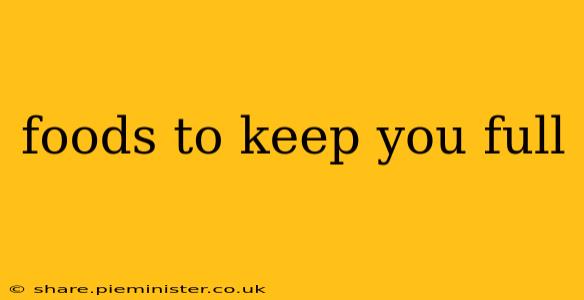Feeling full and satisfied after a meal is crucial for managing your weight, avoiding overeating, and maintaining consistent energy levels throughout the day. The secret lies in choosing foods that are high in nutrients and fiber, promoting satiety and preventing those mid-afternoon cravings. This comprehensive guide explores the best foods to keep you feeling full, along with the science behind their effectiveness.
What Makes You Feel Full?
Before diving into specific foods, let's understand the mechanisms behind satiety. Several factors contribute to feeling full, including:
- Volume: Foods with high water content or that expand in the stomach can create a sense of fullness.
- Protein: Protein is highly satiating, influencing hormones that regulate appetite.
- Fiber: Both soluble and insoluble fiber absorb water, expanding in the digestive system and slowing digestion. This prolonged digestion process keeps you feeling full for longer.
- Fat: While fats are calorie-dense, they also contribute to satiety, slowing gastric emptying.
Top Foods to Keep You Full
Now, let's explore some of the best foods to incorporate into your diet to keep you feeling full and energized.
1. High-Protein Foods
Protein is the undisputed champion of satiety. It triggers the release of hormones that signal fullness to your brain, suppressing appetite more effectively than carbohydrates or fats.
- Examples: Lean meats (chicken, turkey, fish), eggs, beans, lentils, Greek yogurt, tofu, quinoa.
2. High-Fiber Foods
Fiber is essential for digestive health and weight management. It slows down digestion, keeping you feeling full and satisfied for a longer period. Aim for a balanced intake of both soluble and insoluble fiber.
- Examples: Oats, whole grains (brown rice, quinoa, barley), fruits (berries, apples, pears), vegetables (broccoli, Brussels sprouts, spinach), legumes (beans, lentils).
3. Foods High in Water Content
Water-rich foods contribute to satiety by filling your stomach without adding many calories. They help you feel fuller with fewer calories consumed.
- Examples: Soups (broth-based), fruits (watermelon, cucumbers), vegetables (lettuce, celery).
4. Healthy Fats
While high in calories, healthy fats are also satiating. They slow down gastric emptying, keeping you feeling full for longer periods.
- Examples: Avocado, nuts, seeds, olive oil.
5. Foods with a Low Glycemic Index (GI)
Foods with a low GI are digested and absorbed more slowly, leading to a more gradual and sustained release of glucose into the bloodstream. This helps prevent blood sugar spikes and crashes, which can trigger hunger.
- Examples: Whole grains, legumes, most fruits and vegetables.
Frequently Asked Questions (Based on common search queries)
What are some quick and easy snacks to keep you full?
Quick and easy snacks that keep you full include a handful of almonds or other nuts, a hard-boiled egg, Greek yogurt with berries, or a small apple with peanut butter. These combine protein, healthy fats, and fiber for sustained satiety.
What are the best foods to eat for weight loss to keep you full?
Prioritizing high-protein foods, high-fiber foods, and foods with a low glycemic index are ideal for weight loss. These foods promote satiety, help you eat fewer calories overall, and regulate your blood sugar levels.
Are there any specific foods to avoid if you want to stay full longer?
Highly processed foods, sugary drinks, and refined carbohydrates often lead to rapid spikes in blood sugar, followed by energy crashes and increased hunger. These should be minimized for sustained fullness.
How can I incorporate these foods into my daily diet?
Start by gradually incorporating these foods into your breakfast, lunch, and dinner. For instance, add a serving of beans to your salad, choose whole-grain bread over white bread, and include a piece of fruit as a snack. Experiment with different recipes and find what works best for you.
What is the difference between soluble and insoluble fiber?
Soluble fiber dissolves in water, forming a gel-like substance that helps lower cholesterol and regulate blood sugar. Insoluble fiber does not dissolve, adding bulk to your stool and promoting regularity. Both are important for overall health and satiety.
By understanding the factors that contribute to fullness and incorporating these satiety-boosting foods into your diet, you can effectively manage your appetite, maintain consistent energy levels, and support your overall health and well-being. Remember to consult a registered dietitian or healthcare professional for personalized dietary advice.
